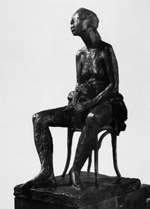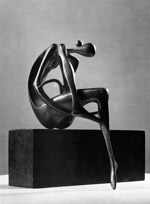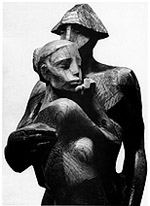Work

The contemporary situation within the field of creative arts in our country enables a pluralism of style with a wide spectre of means of form expression. In individual branches, however, this does not exclude the existence of predominant trends, of topical or fashionable processes or generation features. It may be said of Peter Nižňanský, the sculptor, that he rather defies the main stream of the contemporary younger sculptors' generation. The artists of this generation mostly stand in “position” towards the artistic tradition of classic sculpture, and in the search of their own expression mostly turn to the world’s art trends; they usually present themselves through different installations and objects, rarely through performances or environments, and if in their inspiration, which does not know any limitation of style, history or territory, they refer to their predecessors, they do so with aloofness or grotesque.
Peter Nižňanský, however, openly confesses his anchorage in the home tradition, being at the same time conscious of the continuity with European tradition, and he purposefully does not reflect the latest sculptural impacts and proceedings.
He honours classical sculptural values of the figural conception including the use of traditional materials. He brings his programme respecting the spiritual values of the past, he introduces the elements of harmony, nobility, emotion and beauty in his works.
The portrayal of man’s figure was the basic theme of sculptors from the primeval ages to the beginning of the twentieth century. Only during the almost hundred years of our century has figural sculpture witnessed drastic changes and reversals, and the limits of the genre, including its conceptional scope and content, have been expanded and modified to a great extent. Yet the figural stream in Czech plastic art (with the outstanding baroque tradition) has always been very strong and prominent in an almost uninterrupted line. And although there were alternating periods of high modernism assimilating all possible sculptural eruptions of European art during the development of Czech plastic art, it has always returned to the domestic realistic tradition of Josef Václav Myslbek and the generation of his pupils who laid the basis of modern plastic art and sculpture (S. Sucharda, J. Mařatka, O. Španiel, J. Štursa, etc.). The postwar period was influenced by such personalities like V. Makovský, K. Pokorný, B. Stefan, J. Wagner, H. Wichterlová, etc. The wave of non-figural trends in our arts after 1960 was not a definite retreat of figural tendencies, and there is still a number of prominent artists among the contemporary young generation who have developed sculptural principles based on the Czech classical modernism that follow the narrower conception of a statue as a plastic and sculptural three-dimensional work of art.

During 1978–1984 Peter Nižňanský studied at the Academy of Creative Arts in Prague in the workshop of Prof. Jiří Bradáček. From the very beginning of his independent production it was obvious that he would become a sculptor of an intellectual type of an intense human feeling, with a psychological approach to the chosen theme. The philosophical and symbolical content with an occasional step beyond the genre has become the basic attribute of his art which has struggled for an urgency of intimation through the sculptural statement, and from the aspect of form, the outstanding modelling abilities tending to a prominent hand detail, as well as to a conception of monumentality. This all is directly connected with mastering different sculptural techniques and with a prominent emotion of the qualities of the chosen material, and it is the material that often becomes one of the determining elements of the creation. As a sculptor of the classical type, he is at his happiest when working with classical materials – with wood and stone (he graduated from the monumental masonry stream at a secondary school of applied arts).
Yet today, stone is neither easily obtainable nor cheap and therefore Peter Nižňanský has to be satisfied with artifacts of smaller size. Sculptures like Radost (Joy, 1989, marble, 0.5 m in width) or Tonda (1991, marble, 0.5 m in width) show clean-cut shapes in closed solid forms, whose grace and inner tension of bulk is stressed by the perfectly worked and glazed surface. It is interesting that in spite of a certain luxury of material and technical perfection, both mentioned sculptures of a baby and a dog are exceptionally vivid and effective in their almost moving poesy and simplicity.
The limitation of stone, however, disappears when the author works in a different material. It is the composition of asbestos and cement enabling the artist to develop his tendency to monumentality to above life-size dimensions. Here we find no traces of the tense smooth bulk nor of a certain blocky shape. Here the author makes a full use of his modelling abilities which introduce themselves in a greater and more complicated complexity of compositions, in the movement of the plastic works and their richer contour lines (A Pair, 1989, asbestos-cement, 2.2 m in height), and especially in their surface finish. This leads sometimes to a deep furrowing up of the material, which is uncovered to its innermost marrow, thus increasing the expressive appeal of the work (The Fall, 1989, asbestos-cement, 1.80 m in height).

The plastic modelling principle influences the small-size pieces of plastic art, usually cast in tin or bronze, sometimes with a partial local polychromy. Here the author checks his possibilities, his craftsmanship, here he regenerates his professional self-confidence. Here the great fineness of his hand, various possibilities of surface structures, the pronouncement of impressive moods and fillings can be expressed.
This does not mean, however, that the small-size casts are for Peter Nižňanský only a field of study, sketches or experiments. On the contrary, they are of full value, the parallel and most frequent part of his production (for example The Ballet-Dancer, 1983, tin, 36 cm in height; Faust and Margaret, 1985, tin, 51 cm in height). Always after a certain time, led by his inner discipline and by his fear that his modelling abilities could become a safe and easy way towards thinning and towards a sort of mannerism, the author leaves this field of creation for the sculptural principle and for another favourite material, as for example wood. Its fine and natural qualities offer new possibilities of handling material, of working the surface, which gives the chisel its natural expressiveness; new possibilities of finishing the wood and underline its qualities giving it its final shine by the transparent colourfulness of polychromy. Here the most remarkable work, Harlequin and Columbine (1988, wood, 125 cm in height), represents the author’s favourite theme “The Pairs”.
In his recent works, Peter Nižňanský has begun to free himself from his more or less basically realistic representation in favour of sculpturally purer solid shapes of smooth forms, in which – beside the relations of space – he is engaged in the problems of light and shade (The Sitting Woman II, 1992, tin, 20 cm in height).
From the middle of the 1990ies, he leaves the field of realistic modelling dedicates himself to his clearly stylized figure creations, with relatively complicated compositions of movement. Their clearly composed shapes with pure contours are typical for these sculptures. Their outward design is in these cases a significant element: structured shapes contrasting a smoothly polished shape. These elements are a clear margin for the aerial interspaces which thus become an equivalent artistic form, integrated into his works.
It almost seems as though in his sculptures, Peter Niznansky were playing with the search for the infinite line. The line runs through the seemingly heavier rounded forms and spacial edges, just in order to all but disappear in the rough and fine planes and then regain its shape in the sharp contours. This becomes clear in his sculptures (The Sitting Woman I, The Sitting Woman II, The Lying Woman, or Kindness, Adam and Eve, and The Guard, The Protector, etc). In the second half of the 1990ies, he regularly takes part in sculptor symposia, concentrating on working with wood; he experiments with the shape and the material in monumental proportions. He keeps on profitting from these experiences in his works, mainly made out of bronze. The fact that he himself molds his works, welds them and chisels them in bronze gives him the chance to wholly identify himself with the material. In the last couple of years, he has devoted himself strongly to architectoral and scenic creations.
Peter Niznansky’s oeuvre is diverse. One could point out his activities as a conservator, his working with medals and reliefs, his tombstone concepts (not realized). However, it is not necessary to tiresomely list all his creative activities. He is a sculptor whose artistic future lies ahead of him, in spite of his present oeuvre, which is interesting, qualitatively excellent and attractive.
He is going his own individual way, without the programmatic eclecticism, which is so common today, and without the urge to remain actual at all cost. His work is the logical result of a longtime immanent development, a combination of his own artistic convictions and his concentration. It is drenched in humanism and the awareness of being in a continuity with an artistic tradition.
Which is a very rare phenomenon nowadays.
(1992, 2007)
- Exhibitions
- List od important particiaptions on exhibitions and artistic events.
- Executed works
- Selection of executed works.
- Gallery
- More comprehensive photo gallery of artworks.